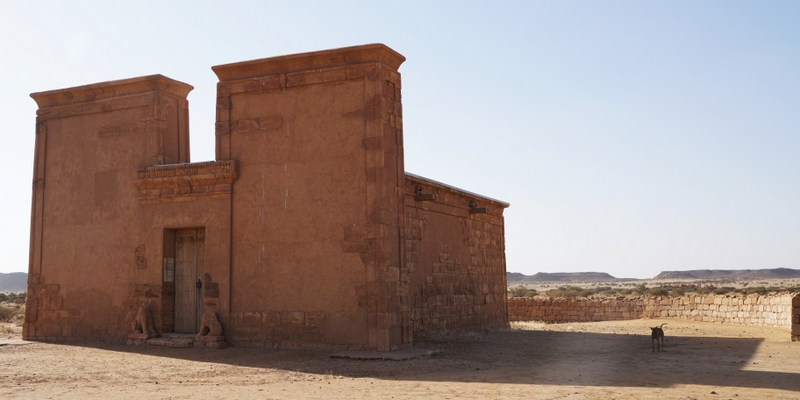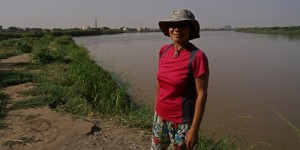26 Days from Cairo to Khartoum: Day 23- 26: Karima, Meroë & Khartoum
Day 23 November 13 Sunday: Karima
I got up at 6am as our group had to serve breakfast by 7am. Jason was already in the kitchen when I arrived at 6:30am. He had the kettle on and we put cereal, oranges, bananas and pineapples, milk, coffee, tea, yogurt, bread etc on the table in the courtyard. I was charged with the task of frying 30 eyes. It took much longer than I thought. I was relieved when the breakfast was over. Everyone gave us a hand in washing and packing. By 8am, we were ready to depart. We had a brief photo-stop at the Meroite pyramids. The golden sun rays lit up the Nubian pyramids with Gebel Barkal as the backdrop. Spiritual and atmospheric!
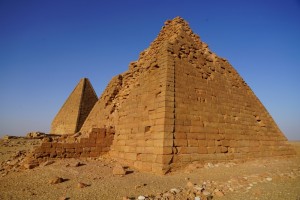 |
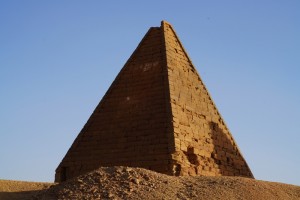 |
The second stop was el Kurru, one of the royal cemeteries used by the Nubian royal family excavated by George Reisner (1867-1942), a renowned American archaeologist. Pyramid building here began with the 25th Dynasty King Piye. Most of the pyramids date to early part of the Kushite period, from Alara of Nubia (795-752 BC) to King Nastasen (335-315 BC). We visited the tomb of Tantamani, a Pharaoh both of Egypt and the Kingdom of Kush at the height of his reign. He was pushed out of Upper Egypt by the Assyrian in 656 BC and died in 653 BC. Entering through a tunnel, we reached two chambers which were covered with well-preserved painting of Orisir and blue stars. They look similar to Egyptian wall paintings but more rustic. We also saw a small temple under excavation nearby. The ruin though small looks impressive with over 20 columns.
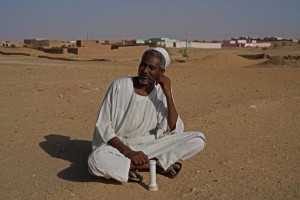 |
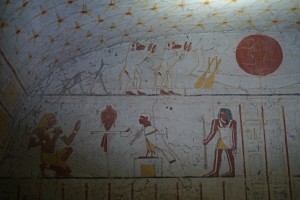 |
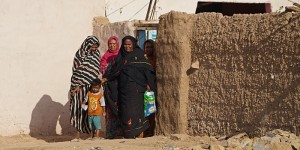 |
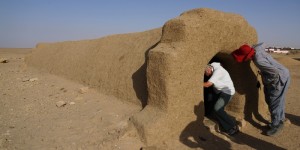 |
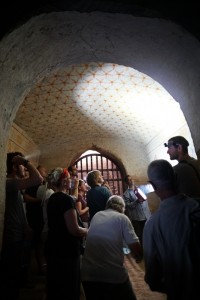 |
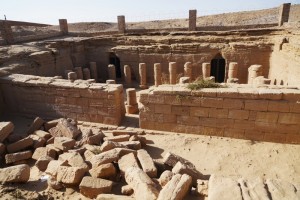 |
Our third stop was at an impressive petrified forest not far from el Kurru. It’s the largest one I have ever seen, spreading some 4km long. Some of the trees are gigantic.
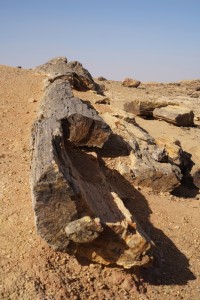 |
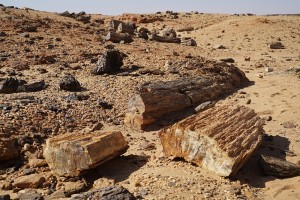 |
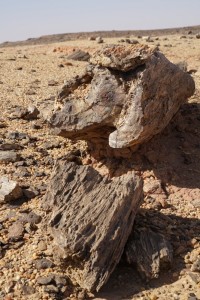 |
Fourth stop to see pyramids at Nuri where some 50 pyramids have been found. These weather-beaten and crumbling pyramids are older than those at Meroë and Jebel Barkal. The great Napatan King Taharqa was the first ruler to be buried here breaking the tradition of interring kings at el Kurru. His pyramid is the largest at Nuri with the base standing at 29m at the base above a large rock-cut burial chamber. The tomb was excavated in 1917 by George Reisner who uncovered a cache of around 1000 shawab ti figures. Ayat said that his tomb is aligned with Jebel Barkel.
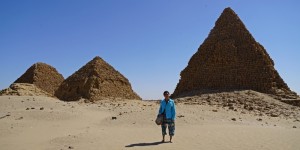 |
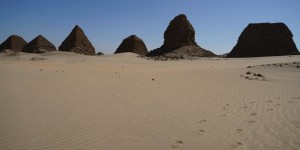 |
Day 24 November 14 Monday:
Pyramids of the Royal Cemetery of Meroë
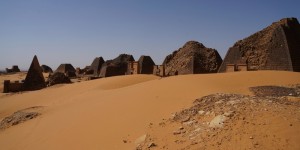 Meroë, an ancient city on the east bank of the Nile approximately 200km north-east of Khartoum, was a flourishing centre for trade, textiles, agriculture and iron industry and the capital of the Kingdom of Kush for several centuries. The site of the city is marked by more than two hundred pyramids in three groups, most of which are in ruins. The site was first brought to the world’s attention in 1821 by the French mineralogist Frédéric Cailiaud (1787-1869). Giuseppe Ferlini, a treasure-hunter, carried out a small-scale excavation in 1834 and ruined some of the pyramids. More serious examinations were carried out by Karl Richard Lepsius in 1844.
Meroë, an ancient city on the east bank of the Nile approximately 200km north-east of Khartoum, was a flourishing centre for trade, textiles, agriculture and iron industry and the capital of the Kingdom of Kush for several centuries. The site of the city is marked by more than two hundred pyramids in three groups, most of which are in ruins. The site was first brought to the world’s attention in 1821 by the French mineralogist Frédéric Cailiaud (1787-1869). Giuseppe Ferlini, a treasure-hunter, carried out a small-scale excavation in 1834 and ruined some of the pyramids. More serious examinations were carried out by Karl Richard Lepsius in 1844.
Around 8th century BC, the Napata kings began to move their burial ground from Nuri to Meroë. The royal families continued to be buried in Meroë until the fall of the Kushite rule in the fourth century AD. The Nubian pyramids had a rubble solid core encased in local sandstone and were covered with a render of lime mortar to give a smooth gleaming surface and the base were painted in red, yellow and blue stars. Tomb chambers were dug directly into the rock below and the pyramid then erected above. A funerary chapel was built in the eastern face of the pyramid. They are much smaller than the Egyptian ones: the largest one is just under 30m in height with an angle approaching 70º.
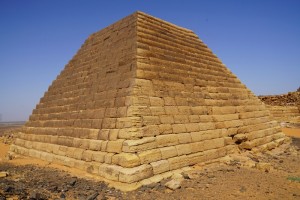 |
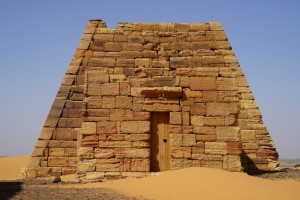 |
We set off at 9am and arrived at 10am at the Northern Cemetery which contains some 30 pyramids in various states of repair. The sun was already fearsomely hot. Apart from a couple of individual travellers and a dozen of workers working under the supervision of an European, we had the expansive desert dotted with toy-like pyramids to ourselves. We visited a number of funerary chapels. Some of the pyramids here had been sadly smashed by Guiseppe Ferlini, the Italian treasure hunter.
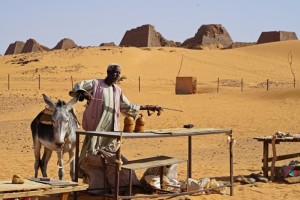 |
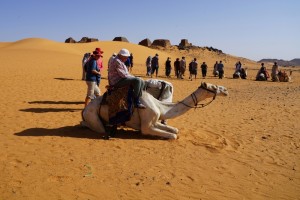 |
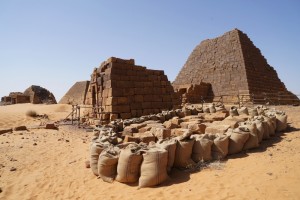 |
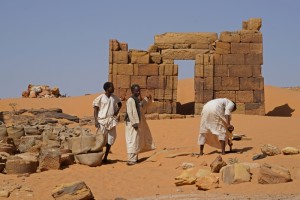 |
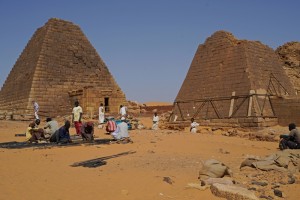 |
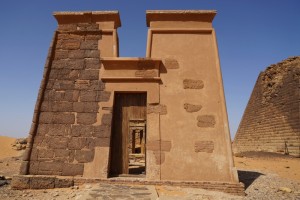 |
Then we walked 500m across the desert to reach the older Southern Cemetery with some 60 smaller pyramids which belonged to the elite of Meroë.
We stopped at Shendi for lunch. Cook Group Five took a cab to shop in the main town. But the group had taken more time than expected to shop and we could not leave till 2:30pm. We drove on dirt road for over an hour before arriving at the ruins of the ancient city of Naqa located 180km northeast of Khartoum.
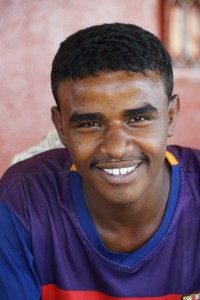 |
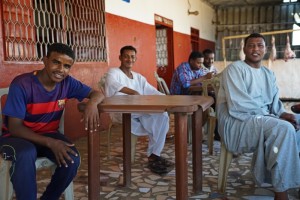 |
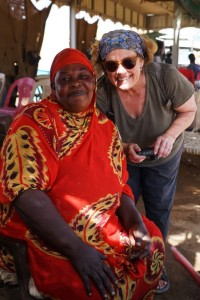 |
Naqa served as one of the centres of the Kingdom of Meroë and a bridge between southern Africa and the Mediterranean. Musawwarat es Sufra is the largest set of Meroitic remains (covering some 55,000m²) and dating back to the Napatan period of the Kushite history (around third century BC) and had been expanded and rebuilt throughout the Meroite period.
We first visited a small temple called ‘Roman Kiosk’ dedicated to the worship of Hathor, with a Greco-Roman appearance.
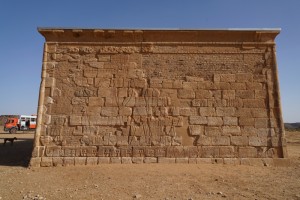 |
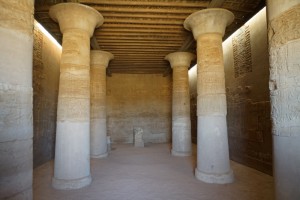 |
Then we spent over half an hour wandering inside the Great Enclosure. There are numerous courtyards, a rambling structure of low walls with ramps, toppled columns and many carvings of elephants. It is not clear the exact purpose of the complex. The most favoured explanation suggests it as a cult centre and pilgrimage site possibly for Apedemak, a lion-headed Kushite god.
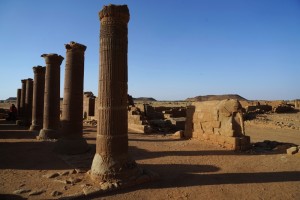 |
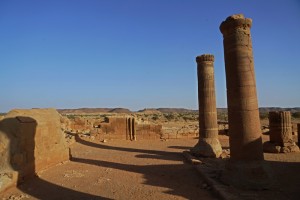 |
The Musawwarat es Sufra ruins in the desert provide a perfect and atmospheric setting for camping. The university care-taker allowed us to set up our tents outside its buildings. We could also use its toilet and shower facilities.
We watched in silence the golden orange sun rays falling upon the ruins at sunset. I soaked in the atmosphere trying to imagine the glories of the once powerful kingdom of Kush and its ancient civilisation. Time is no longer relevant: I want to do nothing but enjoy this most beautiful moment in my life.
We had a wholesome and delicious dinner. The last cook group had bought three roast chickens from the market and Alan prepared fried rice with eggs and vegetables. We even had desserts.
Our perfect day was completed with a full moon. I watched it rising behind the ruins and then lit up the surreal desert scenery. This is the best and most memorable day I had on this 26-day overland journey.
Day 25 November 15 Tuesday: Khartoum
I watched the most enchanting sunrise of this trip: the orange sun first popped up between two hills. Then gradually the glorious sunlight turned the ruins into glittering fortress floating upon the golden desert.
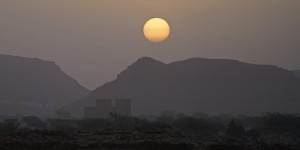 |
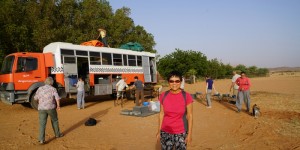 |
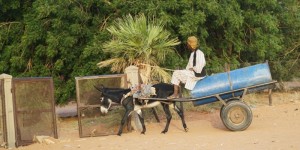 |
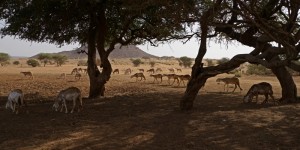 |
After taking a group photo, we drove a short distance and arrived at the famous Lion Temple dedicated to Apedemak. Built around 230 BC by King Arnekhamani, this well preserved temple with most beautiful carvings on all the walls, is considered a classic piece of Kushite architecture. It is fronted by a massive pylon (gateway) with carved reliefs of Natakamani and his queen Amanitore in majestic poses including the holding of prisoners by the hair. From the different facial features, the prisoners might be Roman, Persian and Assyrian. On one side of the outer walls of the temple, the king was represented in the company of the gods Amun, Horus and Apedemak. On the opposite wall finds the queen in the company of female deities including Isis and Hathor. On the rear wall is a carving of Apedemak standing in the middle receiving offerings from Natakamani and Amanitore.
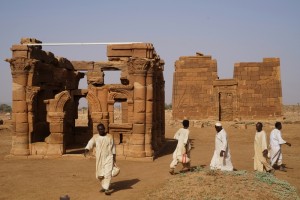 |
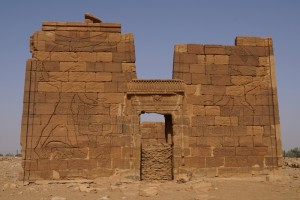 |
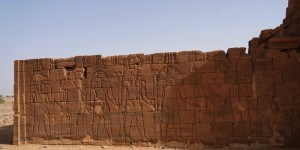 |
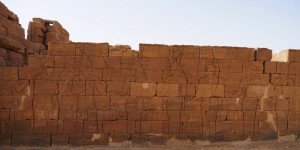 |
Not far from the Apedemak Temple is the Temple of Amun erected in 1st century AD by King Natakamani. I am now familiar with the general layout of a temple. Here there are three rows of the ram god Amun which leads to an outer court with colonnades behind which is the hypostyle hall and finally the an inner sanctuary chamber. The carvings on the walls indicate the main function of each hall/chamber: the first is the Hall of Invitation; the second Hall of Crowning and the last one Hall of Offering.
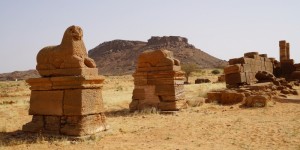 |
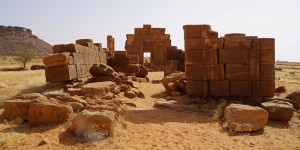 |
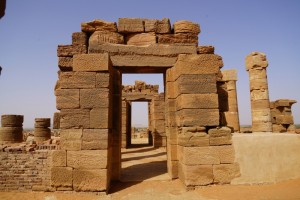 |
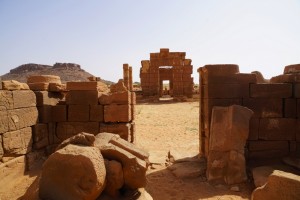 |
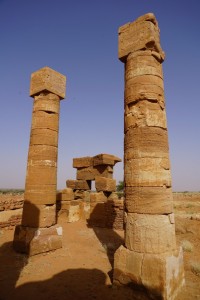 |
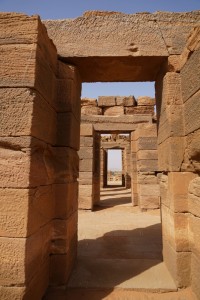 |
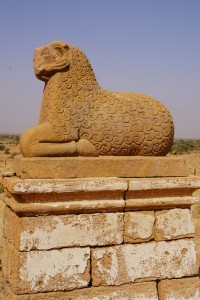 |
Afterward, we drove 40km on dirt road before getting back to the highway. After driving another 100km on the tarmac road with a brief lunch break, we reached our final destination, the Regency Hotel in Khartoum around 3:30pm. According to Simon’s GPS, we had covered about 4700km from Cairo to Khartoum.
I was given a single room for two nights: I was able to wash my dirty clothes, take a hot bath and relax. It is strange to be back to the modern world in a 300 square feet en-suite with an air-conditioning. But modern amenities are not really important for me: I love nature and find desert intriguing. The sand, colours and surreal landscape at sunrise and sunset are bin desert are enchanting. It’s not surprising that I miss the desert soon after having my bath. In the evening, I joined my friends to have dinner in a 4-star hotel built in Nubian style. The restaurant located in a leafy courtyard is pleasantly cool. The ambiance is amicable but the food is average. I spent 190 SDG on food, drink and taxi that evening. Not cheap!
Day 26 November 16 Wednesday: Khartoum
Khartoum, located at the confluence of and divided by the White Nile and the Blue Nile and established in 1821, was the scene of bloody fighting in the late 19th century. After the city fell after a siege by followers of Mahdi Muhammad Ahmad in January 1885, all its inhabitants (estimated 10,000 civilians and members of the garrison) were put to death. Then Omdurman became the scene of a bloody battle on September 2, 1898 when the British forces under Herbert Kitchener defeated the Mahdist forces. It became the capital of independent Sudan. However, Khartoum is a tripartite metropolis with an estimated overall population of over five million people, consisting of Khartoum proper, Khartoum North and Omdurman.
Today, Ayat arranged a guided city tour for $15. We set off in an air-con minibus at 9am and had a full day visiting several attractions.
Ethnographic Museum, a small but interesting museum with nice display and clear explanations in English. The giant wooden ceremonial drum from Azande is impressive.
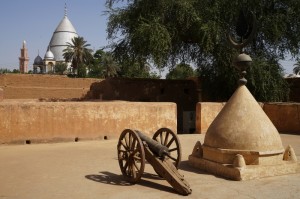 |
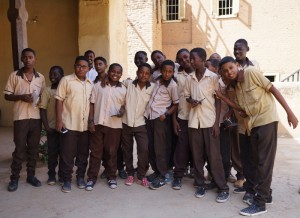 |
Khalifa’ House, the house museum of Mahdi Muhammad Ahmad who lived here till his death. It was first built in 1887-88 and completed in 1891. General Gorden was killed in March 1885 at the Governor’s Palace located in the same vicinity. The grand mosque with Mahdi’s tomb is just opposite the house but we had no opportunity to go in.
Omdurman Souk the largest market in the county with endless alleys and stalls. It is authentic, neat and tidy. The locals are friendly as they see China and Chinese as friends. I had a great time taking photos of the people, the market scene and shopping. I got peanuts and fruits and had a local coffee which is spicy with a fantastic aroma.
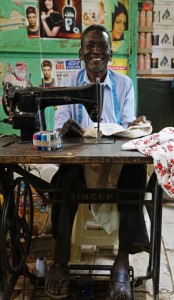 |
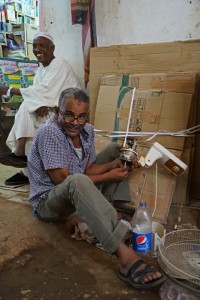 |
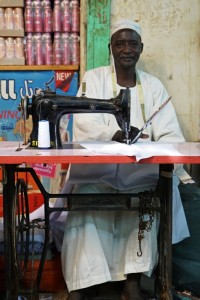 |
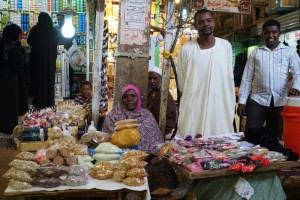 |
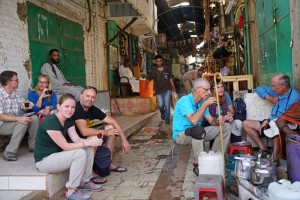 |
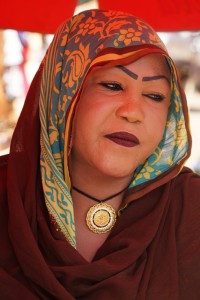 |
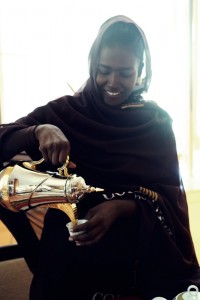 |
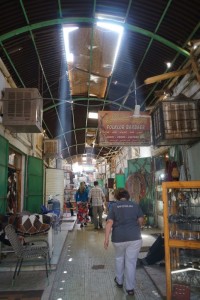 |
Lunch – Ayat took us to a food court with air-conditioning near the Nile. Outside the building one can see part of the old city wall as well as the boat that had come to rescue the besieged British force led by Gordon in 1885. I had a fresh grilled fish and rice for 72 SDG. The food was better than those I had the night before.
Confluence of White and Blue Nile – To reach the confluence, we had to go to the Morgan Family Park. It should be a top attraction but is in a poor state without amenities. I could not get a coffee/tea or ice-cream.
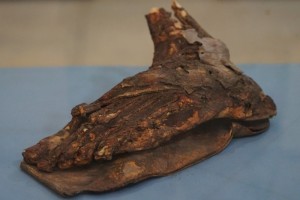 |
Sudan National Museum – When we arrived around 4pm, we were not allowed to enter as it was closed for VVIP visitor who was expected to arrive at 5:15pm. We were annoyed as things are always running on African time i.e. nothing is on time, there was no reason to close it at 4pm. After Ayat’s boss phoned someone in authority, we were permitted to go in for half an hour to look at exhibits on the ground floor. We lost no time and I was impressed by the high quality of the exhibits of the ancient and medieval periods. There are English illustrations too. The well-preserved Kerma pottery are impressive especially the red-brown coloured vessels with a silvery band around. The Early Kerma began around c. 2500-2050 BC and the Final Kerma ended around 1500BC. As expected, half an hour is not enough. I therefore returned the next day to spend another hour and a half.
I had my last dinner in a local restaurant next to the hotel. I had fish again but it was small and bony without much taste. It’s very cheap though (less than 40SDG). I should have taken chicken or kebab, the flavourite choices of the locals.
Day 27 November 17 Thursday: Khartoum (End of the Overland Desert Journey)
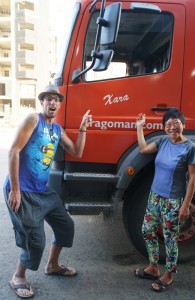 My truck mates would be carrying on their journey to Ethiopia today. I got up early to have breakfast with my buddies and see them off at 8am. I wished them luck for the rest of the journey especially the brave Ten (8 participants, Dutche and Ryan) who would go all the way to Cape Town.
My truck mates would be carrying on their journey to Ethiopia today. I got up early to have breakfast with my buddies and see them off at 8am. I wished them luck for the rest of the journey especially the brave Ten (8 participants, Dutche and Ryan) who would go all the way to Cape Town.
As I would not depart for the airport till midnight, I had a whole day in Khartoum. But I planned to do little. My main interest was to return to the national museum. Ben who was leaving the following day had the same plan. We therefore set off together at 9am on foot to the museum. It’s a good way to experience the city which I find surprisingly tidy, clean and leafy with a beautiful boulevard along the Nile.
On my second visit to the museum, I concentrated on items of interests to me. I took time reading the illustrations of most of the exhibits on the ground floor before going upstair to the new wing – Faras Gallery which features medieval Nubian paintings from the Nile River valley south of the First Cataract. The collection of paintings from the 8th to 14th centuries came from cathedrals and churches in the city of Faras, a large urban centre in medieval kingdom of Nobodia. The rulers were converted to Christianity around AD 548 and the first cathedral was erected here in the 7th century. The colours, styles of the figures and composition of the paintings are distinctive and awesome. I particularly like “Three Youths in Fiery Furnance under the protection of the Archangel Michael”, a reclining figures with Christian symbolism and another large painting of the nativity scene.
Before leaving, I spent time looking at the two Egyptian temples of Buhen and Semna which were originally built by Queen Hatshepsut and Pharaoh Tuthmosis III respectively and relocated to Khartoum upon the flooding of Lake Nasser.
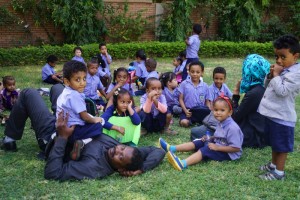 |
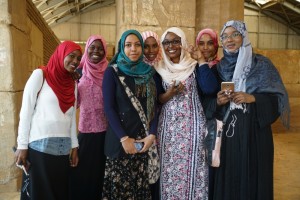 |
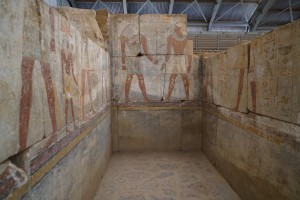 |
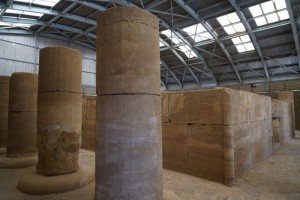 |
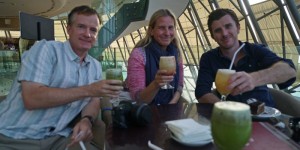 We walked back to our hotel. On the way we went into the grand and luxurious Corinthia Hotel by the Nile. The cheapest room is over US$250 a night. The hotel does not take credit card and one must carry lots of cash to stay there. We had a cup of tea and were served by a beautiful young lady who speaks very good English. She is an university student and works part time here to earn some money. We like the view so much we returned in the afternoon with Cory and Jason to watch sunset. I shared a taxi with Barbara to the airport before midnight. My flight took off on time at 3am for Nairobi after spending a month in Egypt and Sudan.
We walked back to our hotel. On the way we went into the grand and luxurious Corinthia Hotel by the Nile. The cheapest room is over US$250 a night. The hotel does not take credit card and one must carry lots of cash to stay there. We had a cup of tea and were served by a beautiful young lady who speaks very good English. She is an university student and works part time here to earn some money. We like the view so much we returned in the afternoon with Cory and Jason to watch sunset. I shared a taxi with Barbara to the airport before midnight. My flight took off on time at 3am for Nairobi after spending a month in Egypt and Sudan.




